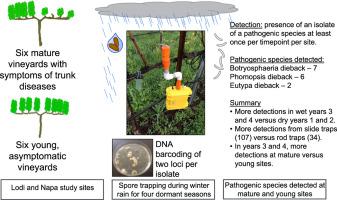Crop Protection ( IF 2.8 ) Pub Date : 2021-08-22 , DOI: 10.1016/j.cropro.2021.105798 Phillip T. Fujiyoshi 1 , Daniel P. Lawrence 2 , Renaud Travadon 2 , Monica Cooper 3 , Paul Verdegaal 4 , Seth Schwebs 5 , Kendra Baumgartner 1

|
Grapevine trunk diseases threaten grape production worldwide. In California, preventative practices (delayed pruning, fungicide applications after pruning) that reduce infections of pruning wounds by pathogen spores produced with rain are timed during the dormant season, when high spore-trap counts of the causal fungi are reported from studies in mature, symptomatic vineyards. Similar studies in young, asymptomatic vineyards are lacking. Given infrequent usage by California growers of preventative practices in young vineyards, empirical data on spore detection may provide convincing evidence to start preventing trunk diseases before symptoms appear. Active and passive spore traps were examined after rain from December to March for four years (2013–2017) in six young, asymptomatic (<5-years-old in year 1) and six mature, symptomatic (13–18-years-old in year 1) vineyards, in Lodi and Napa, California, USA wine-grape regions. We compared detection of spores of causal fungi of Botryosphaeria-, Eutypa-, and Phomopsis diebacks, which are common and widespread trunk diseases in California. From 769 samples, we isolated 15 species in culture, with DNA sequencing of 2 bar-coding loci for species-level identification. Detections (defined as presence of a species at least once per timepoint per site) were sparse in years 1 and 2, and so statistical analyses of detections pooled across timepoints and sites were restricted to years 3 and 4. Most common among all 12 sites and both trap types were Diplodia seriata and Diaporthe chamaeropis. Our novel species-level detections of six Diaporthe species fill a gap in the knowledge of which species can spread during California's dormant season. Overall, detections in young sites in years 3 and 4 (10 and 29 detections, respectively) were significantly lower than those of mature sites (31 and 57 detections, respectively). The presence of spores in young sites, even with no symptomatic vines, suggests preventative practices are needed in young vineyards. Nonetheless, our findings of more detections in mature sites reinforces higher usage by growers of preventative practices in mature, symptomatic vineyards.
中文翻译:

在年轻的、无症状的葡萄园和成熟的、有症状的葡萄园中检测枯死型树干病害真菌的孢子
葡萄树干病威胁着全世界的葡萄生产。在加利福尼亚州,预防措施(延迟修剪,修剪后施用杀真菌剂)可减少雨水产生的病原体孢子对修剪伤口的感染,这些措施是在休眠季节进行的,当时成熟的研究报告了高孢子陷阱计数的致病真菌,有症状的葡萄园。缺乏对年轻、无症状葡萄园的类似研究。鉴于加州种植者很少在年轻的葡萄园中采取预防措施,孢子检测的经验数据可能提供令人信服的证据,在症状出现之前开始预防树干疾病。在 4 年(2013-2017 年)的 12 月至 3 月雨后,对 6 名年轻、无症状(第 1 年 <5 岁)和 6 名成熟、有症状的(第一年 13-18 岁)葡萄园,位于美国加利福尼亚州的洛迪和纳帕葡萄酒葡萄产区。我们比较了 Botryosphaeria-、Eutypa- 和 Phomopsis 枯萎病的致病真菌孢子的检测,它们是加利福尼亚常见和广泛的树干疾病。从 769 个样本中,我们分离出 15 个培养物种,对 2 个条形码基因座进行 DNA 测序以进行物种级鉴定。检测(定义为每个站点每个时间点至少出现一次物种)在第 1 年和第 2 年很少,因此跨时间点和站点汇总的检测统计分析仅限于第 3 年和第 4 年。在所有 12 个站点和站点中最常见两种陷阱类型都是 这是加利福尼亚常见且普遍的躯干疾病。从 769 个样本中,我们分离出 15 个培养物种,对 2 个条形码基因座进行 DNA 测序以进行物种级鉴定。检测(定义为每个站点每个时间点至少出现一次物种)在第 1 年和第 2 年很少,因此跨时间点和站点汇总的检测统计分析仅限于第 3 年和第 4 年。在所有 12 个站点和站点中最常见两种陷阱类型都是 这是加利福尼亚常见且普遍的躯干疾病。从 769 个样本中,我们分离出 15 个培养物种,对 2 个条形码基因座进行 DNA 测序以进行物种级鉴定。检测(定义为每个站点每个时间点至少出现一次物种)在第 1 年和第 2 年很少,因此跨时间点和站点汇总的检测统计分析仅限于第 3 年和第 4 年。在所有 12 个站点和站点中最常见两种陷阱类型都是Diplodia seriata和Diaporthe chamaeropis。我们对六个Diaporthe物种的新物种级检测填补了关于哪些物种可以在加利福尼亚休眠季节传播的知识的空白。总体而言,第 3 年和第 4 年年轻站点的检测(分别为 10 和 29 检测)显着低于成熟站点(分别为 31 和 57 检测)。即使没有出现症状的葡萄藤,在年轻的葡萄园中也存在孢子,这表明在年轻的葡萄园中需要采取预防措施。尽管如此,我们在成熟场地进行更多检测的发现加强了种植者在成熟、有症状的葡萄园中采取预防措施的更多做法。



























 京公网安备 11010802027423号
京公网安备 11010802027423号